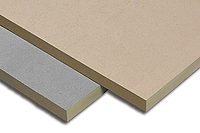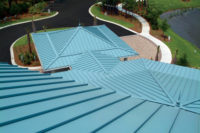
Recent developments, such as the introduction of new "cool roof" technologies, promise to accelerate this change. Over the next few years we can expect to see more and more homeowners consider metal roofing as an economical, long-lasting and energy-efficient alternative to other roofing systems.
What does that mean to you as a roofing contractor? To judge that we must first understand how the industry got to this point - and how individual contractors can build on the progress that has been made.

Metal Roofing's Heritage and Today's Industry
When our company first started supplying product in the mid-70s, virtually all of the projects we engaged in were large-scale. Moreover, they almost always involved government, military or educational institutions - a natural reflection of the heritage of metal roofing. The ancient Greeks and Romans installed metal roofs on major public buildings and the cathedrals and castles of medieval Europe were protected by metal roofs. In this country, many public buildings dating back to Revolutionary times still bear their original metal roofs, including the impressive copper domes of some early courthouses and state capitols.The public, rural and industrial orientation of the metal roofing industry began to shift some 30 to 40 years ago, when leading steel and aluminum producers partnered with the paint and coatings industries to develop finishes that combined durability and low maintenance with aesthetic appeal. Among the key developments were advanced electroplating and sophisticated coil coating techniques, along with zinc-aluminum alloys and polymer coatings, such as Kynar-based finishes. These advanced surfaces enable manufacturers to offer extended warranties of 20 years or more, including lifetime warranties on many residential applications.
Today, metal roofing is well accepted in all sectors of the building industry, although the residential sector still has a long way to go to catch up. Recent industry figures show that manufacturing, commercial and agricultural applications still account for more than 80 percent of the metal roofing market.
Interestingly, we are noticing these days that a significant number of residential architects are specifying the clean, sleek look of standing-seam metal roofing. This is especially true in upscale new homes, where metal offers an eye-catching new alternative to traditional materials.
At the same time, innovative metal shake and tile products are capturing a growing share of the crucial reroofing market. Among the many examples now on the market are our company's aluminum shakes, shingles and tiles, which use a high-resin content paint designed to resist fading, salt air, corrosion and general elemental harshness, applied over a base metal of high-grade alloy aluminum that provides excellent formability and resistance to corrosion.
Another recent industry advance is exemplified by our Armorä line of tile and shake panels. This product is stone-coated, using real rock colored with a ceramic-pigment 3M dye that is permanent and non-fading. The ceramic stone coating is adhered to the steel with baked resin, a process that allows us to offer a lifetime warranty on this product.
The success of such products is based not only on their aesthetic appeal, but also on their financial and structural advantages. These include:
Lightweight - A particularly important trait in re-roofing projects, where metal roofs are typically installed directly over the old roof, eliminating tear-off and disposal costs.
Corrosion resistance
Fire resistance
Wind resistance
Fade resistance
Durability
Minimal maintenance requirements
Energy efficiency
What's more, most new metal roofing systems can be applied over a wood grid, enabling the contractor to correct sags and other flaws in sub-roof appearance. Best of all, from a contractor's perspective, they are easily workable by roofing crews who have conventional shingle experience.
New "Cool Roof" Technologies Add to the Appeal
One of the most important advances in the industry in recent years is the development of "cool roof" technologies that further enhance the metal roofing system's energy efficiency and further enhance its overall lifecycle savings. In our case, for example, a new premium coating means our standing seam roofs are capable of greatly reducing heat absorption, which can save energy, lower cooling costs, and increase the life expectancy of the roof.The key to these benefits is the introduction of ULTRA-Cool™ coatings, a new technology developed by BASF Corp.'s Industrial Coatings Division. These coatings dramatically increase the reflectivity of the roof surface. This, in turn, means less heat absorption by the roofing materials, so less energy is required to keep interior spaces cool and comfortable.
For instance, some ULTRA-Cool colors show a 38.3 percent reflectivity, while identical colors with conventional coatings achieve only a 25.2 percent level. Each additional percentage point of reflectivity reduces metal temperature by 1 degree, so the difference in temperature can be very dramatic, especially in medium to darker colors.
These new coatings also appeal to homeowners who are concerned about the environmental effects of building and growth. Roofing materials that absorb heat also contribute to the "urban heat island" effect, which causes increased demands on power plants. By reflecting heat away from the roof surface, the new coatings reduce this effect, providing broader environmental benefits in addition to individual homeowner savings. Both of these "plus factors" make for a more appealing sales presentation.
Getting in on the Action
So what's the bottom line for a roofing contractor? How can you take advantage of the growing interest in metal roofing? For those not yet offering this popular alternative, now is the ideal time to become part of the fast-growing metal roofing industry. While I wouldn't presume to speak for other manufacturers, I can confidently state that virtually all of us are eager to expand our rosters of affiliated contractors, as evidenced by a commitment to offering strong customer support and training.More specifically, a roofing contractor seeking to establish or expand a presence in the metal roofing market should be willing to address several key requirements relating to both installation and sales:
Installation capabilities - As noted earlier, today's metal roofing systems are easy to install for crews with a modicum of experience. Nevertheless, unusual roof configurations and multiple penetrations pose many of the same challenges for metal roof installations as they do for other roofing systems. Adequate training is not especially burdensome or time-consuming, but it is essential.
Sales approach - Contractors whose sales story focuses on cost alone will need to adjust their approach to succeed with metal roofing. Cost is always important, of course, but with metal roofing the emphasis is on long-term cost and return on investment, rather than the immediate purchase price and installation costs. With 50-year or lifetime warranties, metal roofing systems invariably pay for themselves over time. The added savings in energy costs shorten the payback time even further. Communicating these benefits is crucial to a successful metal roofing sales presentation.
Fortunately, as a contractor, you are not alone. In addition to specific customer support, training and warranty programs from manufacturers, the metal roofing industry at large has taken proactive steps in recent years to help educate consumers about the true state of the art in metal roofing. Industry leaders have invested considerable time and money to promote the product and overcome outdated stereotypes about "noisy roofs you can't walk on." The Metal Construction Association and the Metal Roofing Alliance, along with the American Institute of Steel, are creating new levels of consumer awareness. These efforts, coupled with recent high-profile marketing campaigns by the Metal Building Manufacturers Association and the American Iron and Steel Institute, are helping to promote metal roofing's advantages to consumers.
The next few years are shaping up as an exciting and dynamic time, as a growing number of contractors come to recognize the benefits of offering a premium roofing product that can last a lifetime. What's more, as the speed of information continues to increase, more and more homeowners will discover the good looks, cost effectiveness and environmental benefits metal roofing can provide to their homes. For roofing contractors, that means there has never been a better time to get in on the action.




